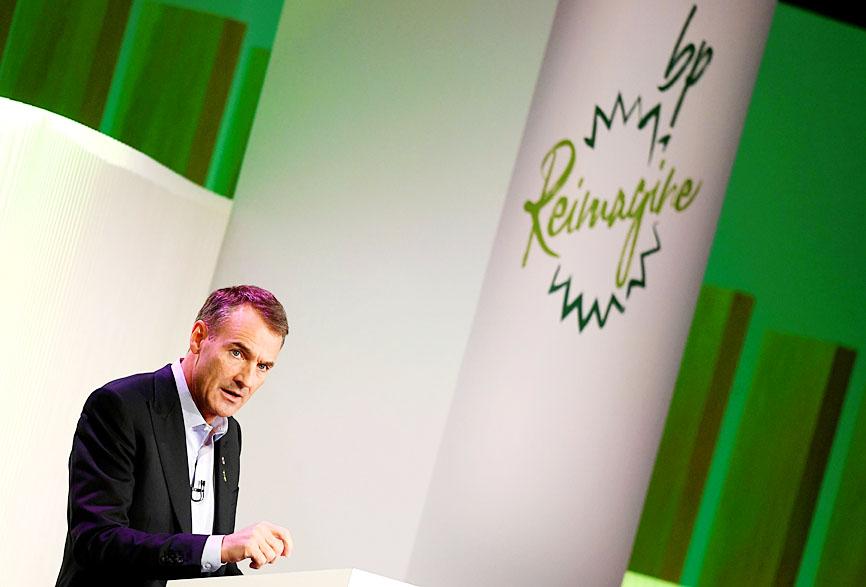BP PLC plunged into a net loss of almost US$16.85 billion in the second quarter, the British oil giant announced yesterday, as the COVID-19 pandemic ravaged demand for oil, sending prices tumbling.
“The ongoing severe impacts of the COVID-19 pandemic continue to create a volatile and challenging trading environment,” BP said in its earnings statement.
“Looking ahead, the outlook for commodity prices and product demand remains challenging and uncertain,” it added.

Photo: Reuters
The quarterly loss after tax of almost US$16.85 billion compared with a net profit of US$1.82 billion in the second quarter of last year, BP said.
“In particular, our reset of long-term price assumptions and the related impairment and exploration write-off charges had a major impact,” chief executive officer Bernard Looney said.
Alongside its results, BP set out details on how it expects to achieve “net zero” carbon emissions for the company by 2050.
Switching from an international oil company to an “integrated energy company,” BP said that over the next decade its oil and gas production is expected to reduce by at least 1 million barrels of oil equivalent a day, or 40 percent when compared with last year’s levels.
“This coming decade is critical for the world in the fight against climate change, and to drive the necessary change in global energy systems will require action from everyone,” Looney said.
The Irish national, who became chief executive of BP in February, had previously said that he wanted “net zero” carbon emissions for the company by the middle of the century.
In the immediate future, BP must rebuild its finances and Looney has already decided to cut about 10,000 jobs, or 15 percent of its global workforce owing to the coronavirus fallout on energy demand and prices.
After companies worldwide closed their doors and airlines grounded planes at the height of the COVID-19 outbreak toward the end of the first quarter, oil prices dropped off a cliff, causing them to briefly turn negative.
However, prices have rebounded sharply in the past few months as governments ease lockdowns and businesses slowly reopen.
To raise much-needed cash, BP recently announced the sale of its petrochemical business to privately owned rival Ineos AG for US$5.0 billion.
In the past year, the energy major also agreed to sell its Alaska operations to Hilcorp Alaska for US$5.6 billion.
Together the disposals were aimed at recouping US$10 billion to finance BP’s US$10.4 billion purchase of US oil and gas operations belonging to mining group BHP Billiton.

UNCERTAINTIES: Exports surged 34.1% and private investment grew 7.03% to outpace expectations in the first half, although US tariffs could stall momentum The Chung-Hua Institution for Economic Research (CIER, 中華經濟研究院) yesterday raised its GDP growth forecast to 3.05 percent this year on a robust first-half performance, but warned that US tariff threats and external uncertainty could stall momentum in the second half of the year. “The first half proved exceptionally strong, allowing room for optimism,” CIER president Lien Hsien-ming (連賢明) said. “But the growth momentum may slow moving forward due to US tariffs.” The tariff threat poses definite downside risks, although the scale of the impact remains unclear given the unpredictability of US President Donald Trump’s policies, Lien said. Despite the headwinds, Taiwan is likely

When Lika Megreladze was a child, life in her native western Georgian region of Guria revolved around tea. Her mother worked for decades as a scientist at the Soviet Union’s Institute of Tea and Subtropical Crops in the village of Anaseuli, Georgia, perfecting cultivation methods for a Georgian tea industry that supplied the bulk of the vast communist state’s brews. “When I was a child, this was only my mum’s workplace. Only later I realized that it was something big,” she said. Now, the institute lies abandoned. Yellowed papers are strewn around its decaying corridors, and a statue of Soviet founder Vladimir Lenin

UNIFYING OPPOSITION: Numerous companies have registered complaints over the potential levies, bringing together rival automakers in voicing their reservations US President Donald Trump is readying plans for industry-specific tariffs to kick in alongside his country-by-country duties in two weeks, ramping up his push to reshape the US’ standing in the global trading system by penalizing purchases from abroad. Administration officials could release details of Trump’s planned 50 percent duty on copper in the days before they are set to take effect on Friday next week, a person familiar with the matter said. That is the same date Trump’s “reciprocal” levies on products from more than 100 nations are slated to begin. Trump on Tuesday said that he is likely to impose tariffs

READY TO BUY: Shortly after Nvidia announced the approval, Chinese firms scrambled to order the H20 GPUs, which the company must send to the US government for approval Nvidia Corp chief executive officer Jensen Huang (黃仁勳) late on Monday said the technology giant has won approval from US President Donald Trump’s administration to sell its advanced H20 graphics processing units (GPUs) used to develop artificial intelligence (AI) to China. The news came in a company blog post late on Monday and Huang also spoke about the coup on China’s state-run China Global Television Network in remarks shown on X. “The US government has assured Nvidia that licenses will be granted, and Nvidia hopes to start deliveries soon,” the post said. “Today, I’m announcing that the US government has approved for us